Hornet vs. Wasp: Here's How to Tell the Difference
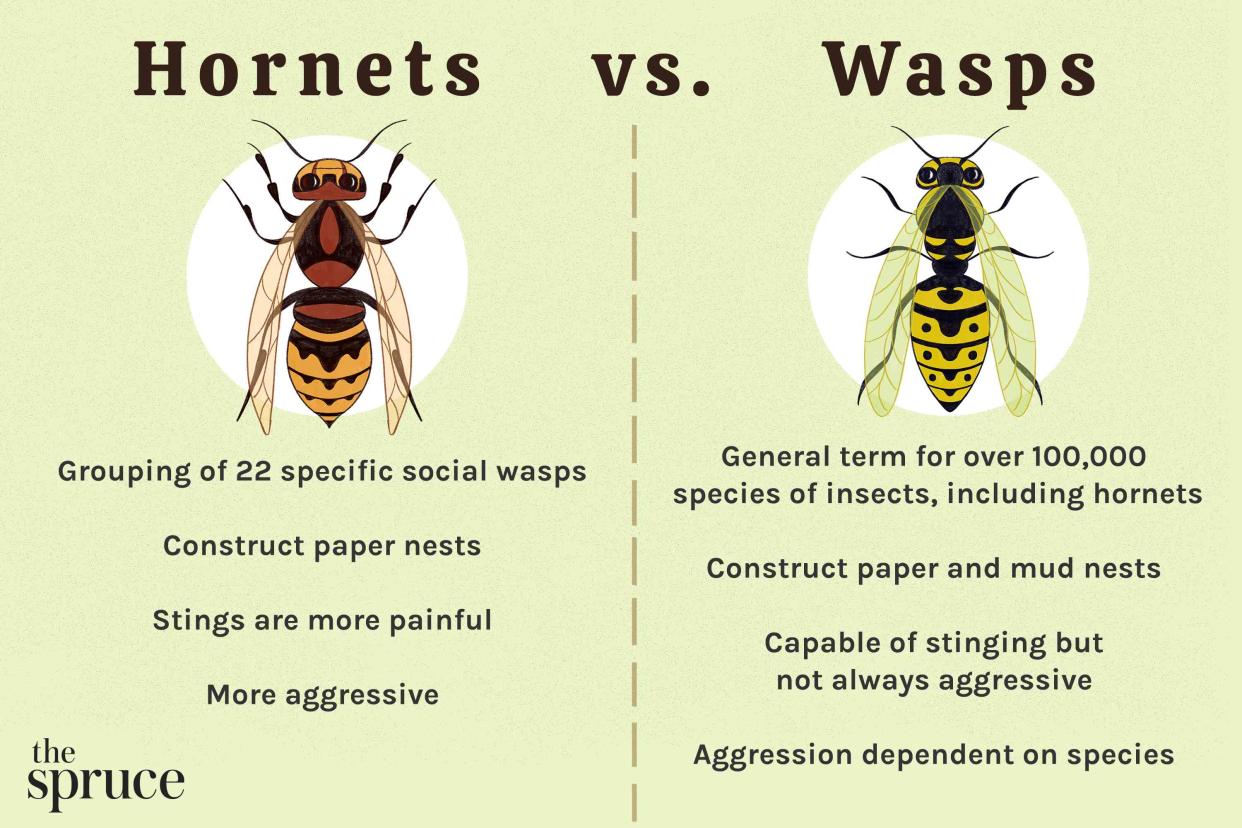
The Spruce / Nez Riaz
As the weather gets warmer, it's time to start keeping an eye out for some often unwelcome fair-weather pests: hornets and wasps.
While they are a nuisance and can put a real damper on your outdoor events, it's not always easy to tell these pests apart. From identification to elimination, equip yourself with everything you need to know about hornets, wasps, and bees. Learn how to identify them so you can confidently tackle any stinging pest issue!
Hornets
Name for 22 specific, social wasps
Name commonly misused for wasps that nest above ground, including bald-faced hornets
Construct paper nests
Stings more painful than other wasps
More aggressive than other wasps
Wasps
General term for over 100,000 species of insects, including hornets
Both social and solitary wasps
Construct paper and mud nests
Capable of stinging but not always aggressive
Aggression dependent on species
Warning
Stinging pests can be dangerous, especially for those allergic to stings. Unlike bees which only sting once, hornets and wasps have smooth stingers capable of stinging multiple times. Identification is critical to effectively controlling stinging pests, but give them space as you try to investigate, and it's always best to leave spraying to the pros. The last thing you want to do is kill your neighborhood honeybee population with improper spraying.
How to Identify Hornets vs. Wasps
It's easy to confuse wasps and hornets, and it doesn't help that they are often called by the wrong names. First, understand that hornets are a type of wasp, but not all wasps are hornets.
'Wasp' is more of a general term, whereas hornets are a more technical grouping of specific large wasps. Since identification is so important to safely controlling and removing pests, let's dive deeper into the main differences and most common species of hornets vs. wasps.
Tips
When dealing with stinging pests, identification isn't just important for your safety; it's vital for the protection of beneficial pollinators like bees. Wasps (including hornets) have smooth, hairless bodies, while bees often have some hair or 'fluff' that helps them collect pollen. Not sure if you're seeing a wasp, hornet, or bee? Start by looking for that cute bee fuzz.
Hornet Identification
True hornets are actually a very specific subcategory that includes 22 species of eusocial wasps, including the Asian giant hornet. Hornets look very similar to yellowjackets, as they are closely related.
Hornets are most common in tropical climates, particularly in Asia. The only true hornet that lives in the U.S. is the European hornet.
European Hornets
European hornets are most likely to sting out of defense if they are at risk of being squished. They generally prefer to avoid confrontation, but they can become defensive of their nest and food sources.
Bald-Faced Hornets
When it comes to hornets, you may be wondering about the bald-faced hornet. Most commonly found in the Southeast U.S., 'hornet' is just a nickname for these pests; they're actually wasps, and more specifically, a type of yellowjacket.
Bald-faced hornets can be very aggressive, especially if you're standing close to their nest. They're still considered mostly beneficial as they help control pests like spiders, flies, and caterpillars, but they should be given space.
There are two main characteristics that can help identify bald-faced hornets:
Their distinct black and white markings
Their large, hanging nests that come to a slight point at the bottom
While a few bald-faced hornets foraging isn't necessarily cause for concern, their nests should be avoided at all costs. They build hanging nests that are commonly constructed around or between the limbs of trees and shrubs. Look for hanging balls of paper and distinct flight paths coming and going from a specific spot, and stay clear! Bald-faced hornets take potential threats seriously. They will aggressively sting and can shoot venom.
What is Eusocial?
Many species of wasps (including hornets) are classified as 'eusocial' wasps. These insects work as a group to forage, construct nests, raise offspring, and protect the queen. The most commonly recognized nests are hanging paper nests, but some wasps make burrows underground.
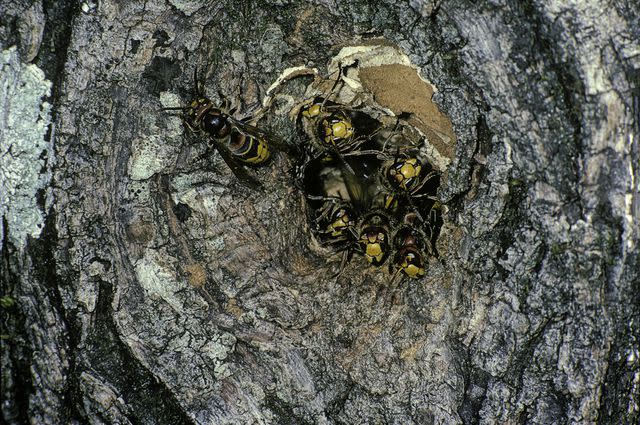
Paul Starosta / Getty Images
European hornets nesting in a tree.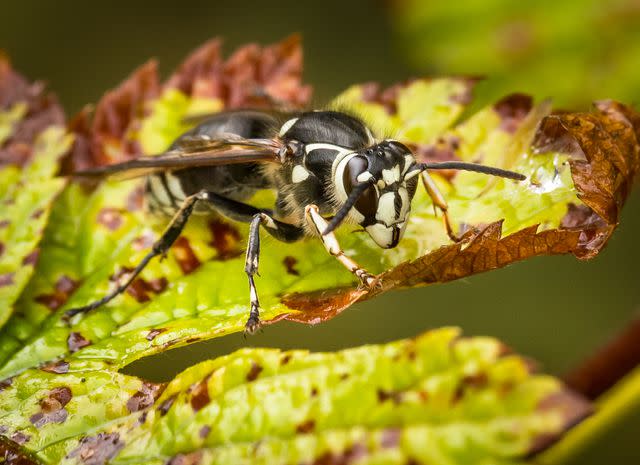
beachgrampa / Getty Images
A bald-faced hornet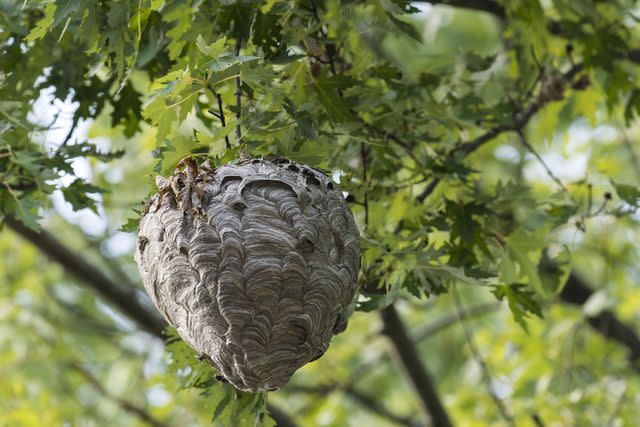
JossK / Getty Images
A bald-faced hornet nestWasp Identification
There are hundreds of thousands of species of wasps, and they vary widely in size and behavior. Believe it or not, the majority of wasps are solitary and go mostly undetected by humans.
Solitary wasp nests include a single adult female who flies solo as she forages for food and builds her nest alone. These solitary nests are sometimes constructed of mud (like the potter wasp or mud dauber), while other solitary wasps dig small burrows.
Paper Wasps
Certain species of wasps are known for their more gentle and docile nature, including many species of paper wasps. These wasps are often happy to go about their business without getting aggressive or stinging and are largely considered beneficial as they help pollinate and prey on nuisance insects. Paper wasps are known for their open-combed, umbrella-shaped hanging nests.
Yellowjackets
More aggressive wasps include yellowjackets and bald-faced hornets (a type of yellowjacket). These pests are sensitive to threats and not afraid to use their stingers. Bald-faced hornets are aggressive, and their nests can contain hundreds of workers. Yellowjacket nests grow even more rapidly and can reach thousands of workers by the end of the season.
Yellowjackets can build hanging nests similar to bald-faced hornets, but they can also end up nesting in wall voids, attic spaces, and burrows. Burrow nests are often the most dangerous. All it takes is a kid or pet running overhead or a lawn mower rolling by to agitate the yellowjackets and prompt them to attack.
Also worth mentioning: sounds in your walls at night can indicate a rodent or animal, but rustling, chewing, or buzzing sounds heard throughout the day could indicate a possible wall void nest. Trust us when we say you don't want yellowjackets to break through the walls and into your living space! If you suspect a wall void nest, you should definitely call a professional to come to take a look as soon as possible.
Tip
Fruit trees that drop fruit in the yard can attract hornets, wasps, bees, and even wildlife and rodents to your yard. Sweet fruit is hard for many pests to resist, so if you want to keep stinging pests out of your yard, make sure any dropped fruit is picked up regularly.
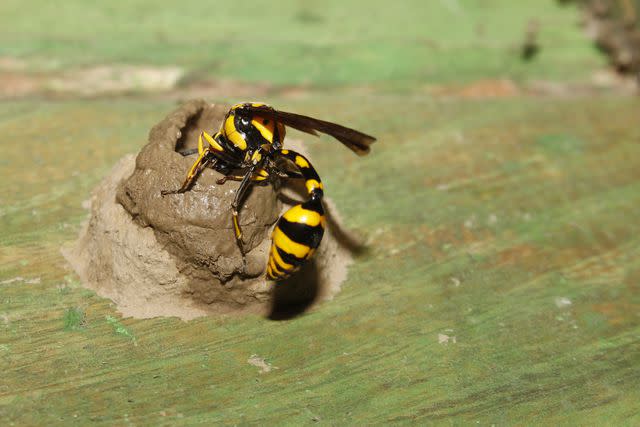
MANORANJAN MISHRA / Getty Images
A solitary wasp constructing a mud nest.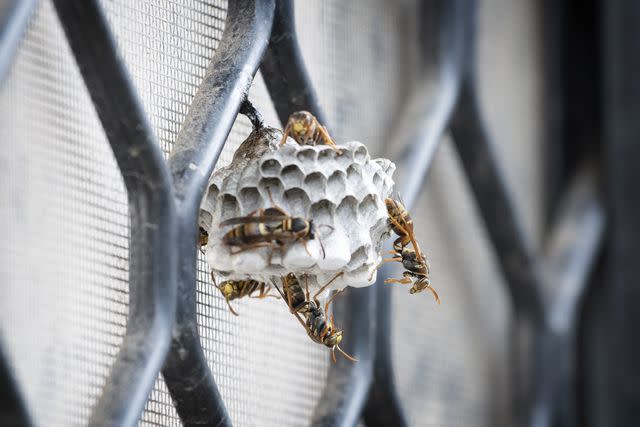
11Audrey11 / Getty Images
A small paper wasp nest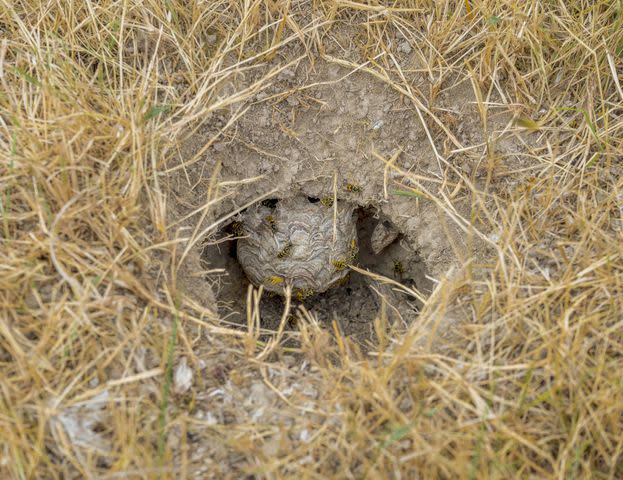
prill / Getty Images
A yellow jacket nest inside a burrowHornet and Wasp Lifecycles
Considering all hornets, wasps, and bees are in the same order of classification (Hymenoptera), all of them follow the same lifecycle. Understanding the lifecycle of these insects can help us not only appreciate them but also mitigate potential risks.
Hornets, wasps, and bees all go through a sequence of distinct developmental phases: egg, larva, pupa, and adult. This process is called complex metamorphosis, and while the duration and complexity of each stage vary depending on the species, they all share similar characteristics.
In colder areas with a true winter, these pests are seasonal, meaning spring is the best time to be on the lookout for small paper nests being constructed, especially around your eaves and roofline. When nests are small, treatment will be less complicated - and less dangerous.
Tip
Noticing a small, open-faced nest under your porch or eaves? These are probably non-aggressive paper wasps. As long as the nest is small (and they're truly paper wasps), it can be scraped or knocked down with a broom and quickly stomped with a boot or tennis shoe.
This will prevent the nest from growing bigger throughout the warm months and save you some money on professional treatment. You don't have to stomp the nest, but if you don't crush it, the wasps could start re-building nearby.
Hornet and Wasp Stings
Unlike bees, hornets and wasps can sting repeatedly. Bees use their sting for protection while hornets and wasps have smooth stingers they use for hunting. Because their stingers are not barbed, they are capable of stinging repeatedly, making them especially dangerous for people with sting allergies. Their stings are painful, and they're known to attack in a group, primarily when someone or something gets too close to their nest.
To avoid hornet and wasp stings, start by knowing what signs to look for:
Foraging areas: If there are specific plants or flowers that hornets or wasps frequent, give these plants space. If left alone to forage, they shouldn't create issues and will actually work to reduce nuisance pests around your yard, including spiders and flies. Just keep an eye out to make sure there isn't a nest nearby.
Nesting sites: Since hornets and wasps can get aggressive over their nests, it's best to stay clear. The only problem? Their nests can be hard to spot. Keep an eye out for wasps or hornets flying directly to and from a specific spot. We're not talking about coming and going from a feeding site, we're talking about flying directly in and out of a shrub, tree, or hole in the ground.
For more severe sting situations (including sting allergies) seek medical attention right away. If you are not sensitive to stings and the issue is not severe, follow these steps:
Remove the stinger if still attached
Clean the sting site
Apply a sting cream if you have any
Use an ice pack to reduce swelling
Monitor for any signs of an allergic reaction (hives, difficulty breathing)
If signs of allergic reaction appear, seek medical attention immediately
Read Next: 8 Natural Home Wasp Repellant Tips

